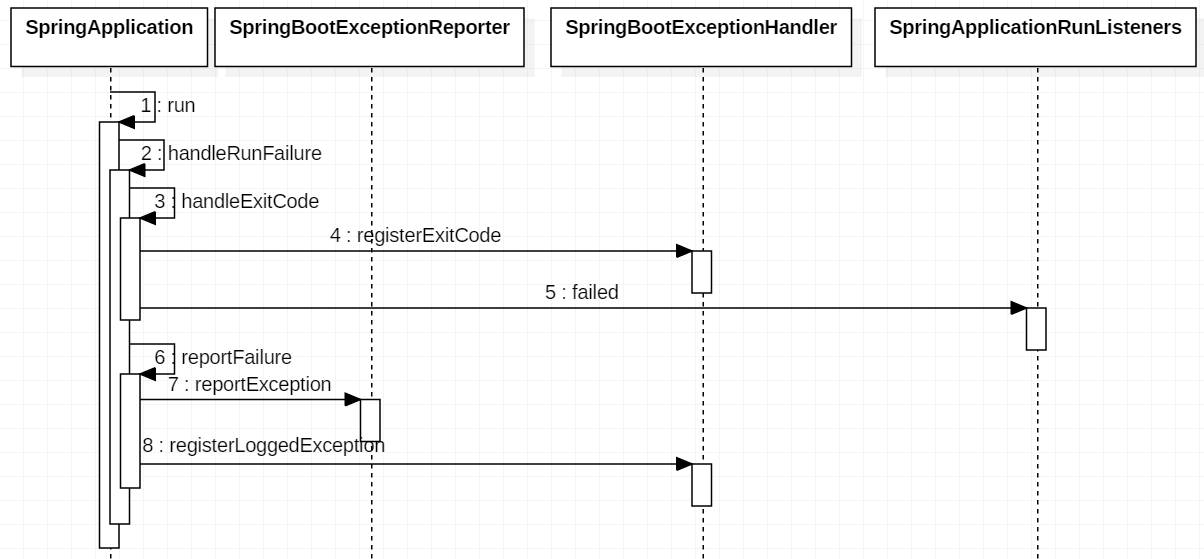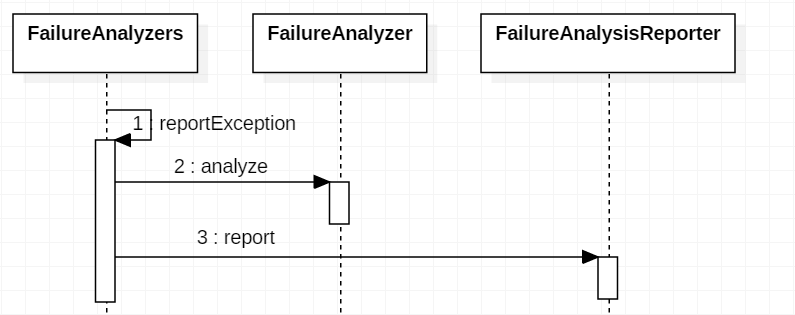Spring Boot 异常处理
本节介绍一下 Spring Boot 启动时是如何处理异常的?核心类是 SpringBootExceptionReporter 和 SpringBootExceptionHandler。
一、Spring Boot 异常处理流程

public ConfigurableApplicationContext run(String... args) {
Collection<SpringBootExceptionReporter> exceptionReporters = new ArrayList<>();
try {
exceptionReporters = getSpringFactoriesInstances(
SpringBootExceptionReporter.class,
new Class[] { ConfigurableApplicationContext.class }, context);
catch (Throwable ex) {
handleRunFailure(context, ex, exceptionReporters, listeners);
throw new IllegalStateException(ex);
}
try {
listeners.running(context);
} catch (Throwable ex) {
// 处理异常
handleRunFailure(context, ex, exceptionReporters, null);
throw new IllegalStateException(ex);
}
return context;
}
run 方法中的异常处理都交给 handleRunFailure 完成。
private void handleRunFailure(ConfigurableApplicationContext context,
Throwable exception,
Collection<SpringBootExceptionReporter> exceptionReporters,
SpringApplicationRunListeners listeners) {
try {
try {
// 1. ExitCodeGenerators 根据异常获取是正常不是异常退出
handleExitCode(context, exception);
if (listeners != null) {
listeners.failed(context, exception);
}
} finally {
// 2. SpringBootExceptionReporter 处理异常报告
reportFailure(exceptionReporters, exception);
if (context != null) {
context.close();
}
}
} catch (Exception ex) {
logger.warn("Unable to close ApplicationContext", ex);
}
// 3. 重新报出异常,由 SpringBootExceptionHandler 处理
ReflectionUtils.rethrowRuntimeException(exception);
}
handleRunFailure 中主要依赖了三个组件完成异常的处理:
SpringBootExceptionReporter生成错误报告并处理,主要是用于输出日志。SpringBootExceptionHandler实现了 Thread#UncaughtExceptionHandler 接口,可以在线程异常关闭的时候进行回调。主要用于退出程序 System.exit(xxx)SpringApplicationRunListenersSpring Boot 事件机制
1.1 handleExitCode
handleExitCode 根据异常的类型决定如何退出程序,并将 exitCode(0 或 1) 退出码注册到 SpringBootExceptionHandler 上。
private void handleExitCode(ConfigurableApplicationContext context,
Throwable exception) {
// 根据异常判断是正常退出还是异常退出
int exitCode = getExitCodeFromException(context, exception);
if (exitCode != 0) {
if (context != null) {
context.publishEvent(new ExitCodeEvent(context, exitCode));
}
SpringBootExceptionHandler handler = getSpringBootExceptionHandler();
if (handler != null) {
// 正常退出或异常退出,System.exit(exitCode) 用
handler.registerExitCode(exitCode);
}
}
}
getExitCodeFromException 根据异常判断是正常退出还是异常退出,委托给了 ExitCodeGenerators,最后将退出码注册到 SpringBootExceptionHandler 上。
1.2 reportFailure
private void reportFailure(Collection<SpringBootExceptionReporter> exceptionReporters,
Throwable failure) {
try {
for (SpringBootExceptionReporter reporter : exceptionReporters) {
if (reporter.reportException(failure)) {
registerLoggedException(failure);
return;
}
}
} catch (Throwable ex) {
}
if (logger.isErrorEnabled()) {
logger.error("Application run failed", failure);
registerLoggedException(failure);
}
}
reportFailure 委托 SpringBootExceptionReporter 处理异常,并将异常注册到 SpringBootExceptionHandler 上。
二、ExitCodeGenerators
private int getExitCodeFromException(ConfigurableApplicationContext context,
Throwable exception) {
// ExitCodeGenerators 处理异常
int exitCode = getExitCodeFromMappedException(context, exception);
// 如果没有分析出来,则判断这个异常本身是实现了 ExitCodeGenerator 接口,继续分析
if (exitCode == 0) {
exitCode = getExitCodeFromExitCodeGeneratorException(exception);
}
return exitCode;
}
// 从 context 中获取所有的 ExitCodeExceptionMapper 来分析异常
private int getExitCodeFromMappedException(ConfigurableApplicationContext context,
Throwable exception) {
if (context == null || !context.isActive()) {
return 0;
}
ExitCodeGenerators generators = new ExitCodeGenerators();
Collection<ExitCodeExceptionMapper> beans = context
.getBeansOfType(ExitCodeExceptionMapper.class).values();
// 将 exception 和 ExitCodeExceptionMapper 封装成 ExitCodeGenerator 注册到 generators 中
generators.addAll(exception, beans);
return generators.getExitCode();
}
// 异常本身实现了 ExitCodeGenerator 接口
private int getExitCodeFromExitCodeGeneratorException(Throwable exception) {
if (exception == null) {
return 0;
}
if (exception instanceof ExitCodeGenerator) {
return ((ExitCodeGenerator) exception).getExitCode();
}
return getExitCodeFromExitCodeGeneratorException(exception.getCause());
}
ExitCodeGenerator 和 ExitCodeExceptionMapper 接口如下,ExitCodeGenerators 管理多个 ExitCodeGenerator。Spring 将 exception 和 ExitCodeExceptionMapper 封装成 ExitCodeGenerator 注册到 ExitCodeGenerators 中便于统一处理。
@FunctionalInterface
public interface ExitCodeGenerator {
int getExitCode();
}
@FunctionalInterface
public interface ExitCodeExceptionMapper {
int getExitCode(Throwable exception);
}
三、SpringBootExceptionReporter
SpringBootExceptionReporter 也是在 spring.factories 中配置的,默认实现为 FailureAnalyzers。FailureAnalyzers 持有多个 FailureAnalyzer 来分析异常生成 FailureAnalysis 报告,由 FailureAnalysisReporter 处理。这些类都位于 org.springframework.boot.diagnostics 包下。具体的配置如下:
# Error Reporters
org.springframework.boot.SpringBootExceptionReporter=
org.springframework.boot.diagnostics.FailureAnalyzers
# Failure Analyzers
org.springframework.boot.diagnostics.FailureAnalyzer=
org.springframework.boot.diagnostics.analyzer.BeanCurrentlyInCreationFailureAnalyzer,
org.springframework.boot.diagnostics.analyzer.BeanDefinitionOverrideFailureAnalyzer,
org.springframework.boot.diagnostics.analyzer.BeanNotOfRequiredTypeFailureAnalyzer,
org.springframework.boot.diagnostics.analyzer.BindFailureAnalyzer,
org.springframework.boot.diagnostics.analyzer.BindValidationFailureAnalyzer,
org.springframework.boot.diagnostics.analyzer.UnboundConfigurationPropertyFailureAnalyzer,
org.springframework.boot.diagnostics.analyzer.ConnectorStartFailureAnalyzer,
org.springframework.boot.diagnostics.analyzer.NoSuchMethodFailureAnalyzer,
org.springframework.boot.diagnostics.analyzer.NoUniqueBeanDefinitionFailureAnalyzer,
org.springframework.boot.diagnostics.analyzer.PortInUseFailureAnalyzer,
org.springframework.boot.diagnostics.analyzer.ValidationExceptionFailureAnalyzer,
org.springframework.boot.diagnostics.analyzer.InvalidConfigurationPropertyNameFailureAnalyzer,
org.springframework.boot.diagnostics.analyzer.InvalidConfigurationPropertyValueFailureAnalyzer
# FailureAnalysisReporters
org.springframework.boot.diagnostics.FailureAnalysisReporter=
org.springframework.boot.diagnostics.LoggingFailureAnalysisReporter
FailureAnalyzers 处理流程也非常简单。

四、SpringBootExceptionHandler
Thread#UncaughtExceptionHandler 处理线程异常关闭时未处理的异常:https://www.cnblogs.com/jadic/p/3532580.html
SpringBootExceptionHandler 实现了 Thread#UncaughtExceptionHandler 接口,在线程关闭时退出程序。
@Override
public void uncaughtException(Thread thread, Throwable ex) {
try {
if (isPassedToParent(ex) && this.parent != null) {
this.parent.uncaughtException(thread, ex);
}
} finally {
this.loggedExceptions.clear();
if (this.exitCode != 0) {
System.exit(this.exitCode);
}
}
}
那 SpringBootExceptionHandler 是怎么注册到线程上的呢?实际上在初始化类的时候就注册到线程上了。
// 初始化类的时候就实例了 SpringBootExceptionHandler
private static LoggedExceptionHandlerThreadLocal handler = new LoggedExceptionHandlerThreadLocal();
private static class LoggedExceptionHandlerThreadLocal
extends ThreadLocal<SpringBootExceptionHandler> {
@Override
protected SpringBootExceptionHandler initialValue() {
SpringBootExceptionHandler handler = new SpringBootExceptionHandler(
Thread.currentThread().getUncaughtExceptionHandler());
// 将 SpringBootExceptionHandler 注册到当前线程上
Thread.currentThread().setUncaughtExceptionHandler(handler);
return handler;
}
}
获取 SpringBootExceptionHandler 实例:
static SpringBootExceptionHandler forCurrentThread() {
return handler.get();
}
每天用心记录一点点。内容也许不重要,但习惯很重要!